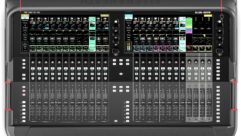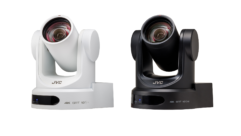Streaming technology is among the important AV categories to surge in response to Covid and continues to be relevant to hybrid work and life.
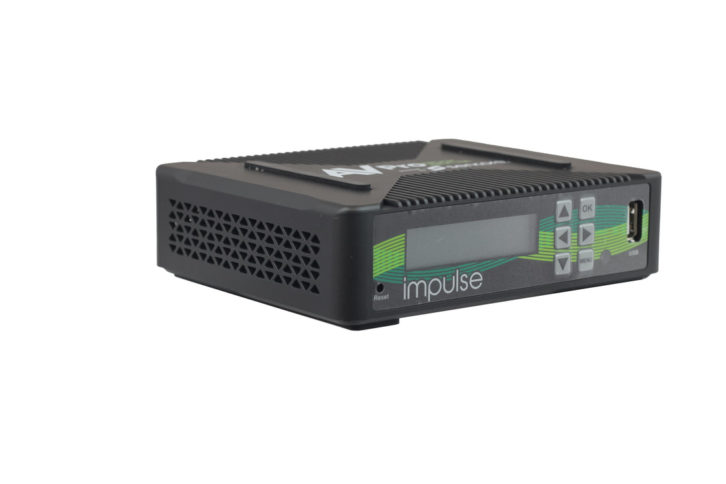 For portable streaming, the AVPro Edge Impulse single-channel streamer/recorder can stream and simultaneously record directly to a SD card or USB flash drive. The Impulse features HDMI, component and SDI inputs, SDI output, direct audio input, and an RS-232 port. Capable of handling video signals at a resolution up to 1080p, the device’s capabilities include H.264 and H.265 encoding. The USB port is on the front panel along with an LCD screen with navigation buttons for setup and operation. There is also an LED indicator that changes colors to indicate operational status. The RJ-45 port allows it to be set up and managed on IP with a web browser.
For portable streaming, the AVPro Edge Impulse single-channel streamer/recorder can stream and simultaneously record directly to a SD card or USB flash drive. The Impulse features HDMI, component and SDI inputs, SDI output, direct audio input, and an RS-232 port. Capable of handling video signals at a resolution up to 1080p, the device’s capabilities include H.264 and H.265 encoding. The USB port is on the front panel along with an LCD screen with navigation buttons for setup and operation. There is also an LED indicator that changes colors to indicate operational status. The RJ-45 port allows it to be set up and managed on IP with a web browser.
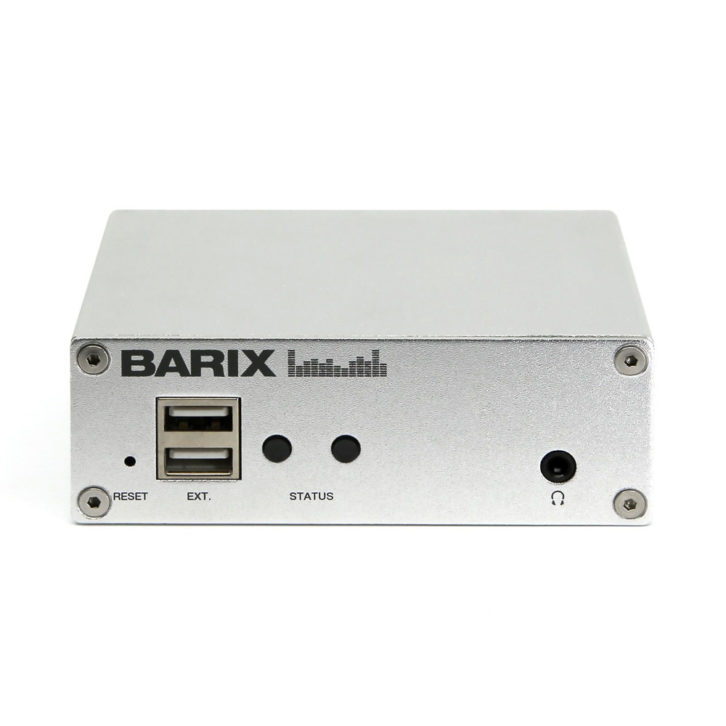 The Barix Exstreamer M400 IP Audio Decoder, is the first model in a new generation of the company’s Exstreamer IP audio decoder family. Powered by Barix’s Linux-based IPAM 400 audio module, the Exstreamer M400 has higher processing power than previous Exstreamer models and a more programmable, software-driven architecture for easier expansion, rapid prototyping, and customization. An increased buffer size and advanced buffer management technology improve network performance disruptions. Expanded support for IT security standards includes HTTPS, support for audio streams, and a web-based management interface, plus secure, encrypted SIP (voice-over-IP) communications using TLS and SRT. The Exstreamer M400 features stereo, line-level, analog audio output with RCA-type connections and can decode streams in MP3, AAC-HE, FLAC, PCM, Opus, and Ogg Vorbis formats, as well as supporting SIP and secure SIP in peer-topeer and server modes. Other new features include IPV6 support, internal audio file storage with externally-triggered playback, and support for Singlewire Software’s InformaCast and Syn-Apps (now part of Intrado) emergency notification platforms with automatic endpoint registration. The Exstreamer M400 initially targets IP audio applications in the professional AV market, including background music, paging, SIP/VoIP integration, and emergency notifications. AES67 support enables the decoder to be configured as a dedicated AES67 receiver and decoder, enabling integration into AES67-based AoIP networks and interoperability with Dante-compatible devices.
The Barix Exstreamer M400 IP Audio Decoder, is the first model in a new generation of the company’s Exstreamer IP audio decoder family. Powered by Barix’s Linux-based IPAM 400 audio module, the Exstreamer M400 has higher processing power than previous Exstreamer models and a more programmable, software-driven architecture for easier expansion, rapid prototyping, and customization. An increased buffer size and advanced buffer management technology improve network performance disruptions. Expanded support for IT security standards includes HTTPS, support for audio streams, and a web-based management interface, plus secure, encrypted SIP (voice-over-IP) communications using TLS and SRT. The Exstreamer M400 features stereo, line-level, analog audio output with RCA-type connections and can decode streams in MP3, AAC-HE, FLAC, PCM, Opus, and Ogg Vorbis formats, as well as supporting SIP and secure SIP in peer-topeer and server modes. Other new features include IPV6 support, internal audio file storage with externally-triggered playback, and support for Singlewire Software’s InformaCast and Syn-Apps (now part of Intrado) emergency notification platforms with automatic endpoint registration. The Exstreamer M400 initially targets IP audio applications in the professional AV market, including background music, paging, SIP/VoIP integration, and emergency notifications. AES67 support enables the decoder to be configured as a dedicated AES67 receiver and decoder, enabling integration into AES67-based AoIP networks and interoperability with Dante-compatible devices.
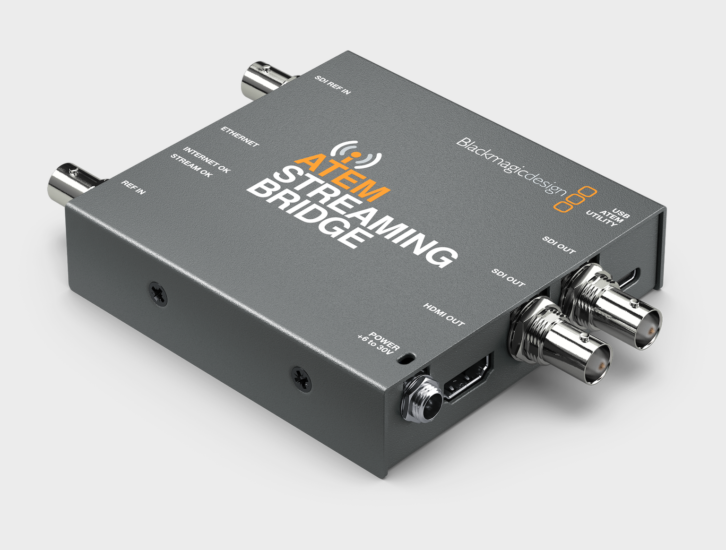 The Blackmagic Design ATEM Streaming Bridge converter lets customers receive a H.264 stream from any ATEM Mini Pro switcher and convert it back to SDI and HDMI video. This means customers can send video to remote locations around their local Ethernet network, or via the Internet globally. Setup is easy as the ATEM software utility can create setup files that customers can email to remote ATEM Mini Pro studios. ATEM Streaming Bridge is the perfect way to use ATEM Mini Pro as a remote broadcast studio. Blackmagic ATEM Mini switchers make it easy to create professional multi camera productions for live streaming to YouTube and innovative business presentations using Skype or Zoom.
The Blackmagic Design ATEM Streaming Bridge converter lets customers receive a H.264 stream from any ATEM Mini Pro switcher and convert it back to SDI and HDMI video. This means customers can send video to remote locations around their local Ethernet network, or via the Internet globally. Setup is easy as the ATEM software utility can create setup files that customers can email to remote ATEM Mini Pro studios. ATEM Streaming Bridge is the perfect way to use ATEM Mini Pro as a remote broadcast studio. Blackmagic ATEM Mini switchers make it easy to create professional multi camera productions for live streaming to YouTube and innovative business presentations using Skype or Zoom.
 The Contemporary Research 232-ATSC 4K HDTV tuner is one of the most widely installed tuners in the AV and broadcast industries. It offers video output scaling up to 4K, the ability to decode channels up to 1080p as well as the option for IP streaming via Ethernet output. The IP streaming option offers new flexibility for IPTV network integration. Starting with Version 2.01 firmware, users can stream off-air or QAM channels and output the tuned MPEG stream as a Unicast or Multicast AV Over IP Stream. Channels may also be embedded into digital signage players. Broadcasters will find the new firmware useful when installing the 232-ATSC 4K HD Tuner at their antenna sites to monitor the signal over VPN. In addition to the IP features, the 232-ATSC 4K remains a commercial HDTV tuner that can receive both analog and digital off-air, analog, and clear QAM cable channels, controllable via RS-232, Ethernet, and IR. Full interactive control and configuration is also available from onboard Web pages. The 232-ATSC 4K is compatible with control systems from AMX, Crestron, Extron, RTI, and others, as well as remaining fully compatible with the RS-232, Telnet, and IR commands as with previous Contemporary Research ATSC tuners.
The Contemporary Research 232-ATSC 4K HDTV tuner is one of the most widely installed tuners in the AV and broadcast industries. It offers video output scaling up to 4K, the ability to decode channels up to 1080p as well as the option for IP streaming via Ethernet output. The IP streaming option offers new flexibility for IPTV network integration. Starting with Version 2.01 firmware, users can stream off-air or QAM channels and output the tuned MPEG stream as a Unicast or Multicast AV Over IP Stream. Channels may also be embedded into digital signage players. Broadcasters will find the new firmware useful when installing the 232-ATSC 4K HD Tuner at their antenna sites to monitor the signal over VPN. In addition to the IP features, the 232-ATSC 4K remains a commercial HDTV tuner that can receive both analog and digital off-air, analog, and clear QAM cable channels, controllable via RS-232, Ethernet, and IR. Full interactive control and configuration is also available from onboard Web pages. The 232-ATSC 4K is compatible with control systems from AMX, Crestron, Extron, RTI, and others, as well as remaining fully compatible with the RS-232, Telnet, and IR commands as with previous Contemporary Research ATSC tuners.
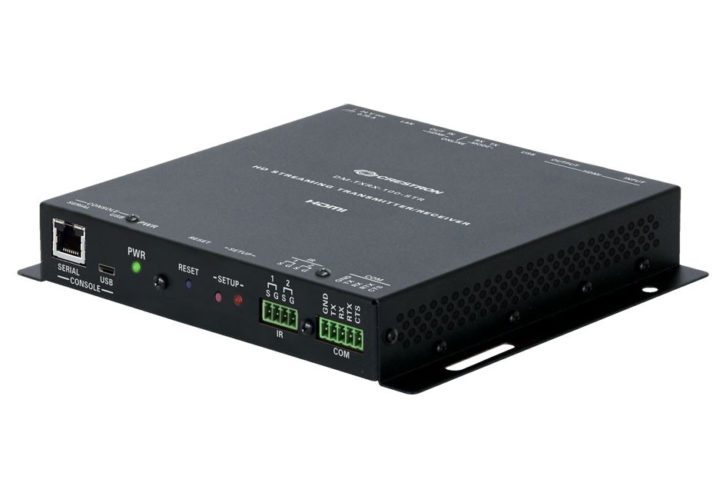 The Crestron DM-TXRX-100-STR HD H.264 streaming transmitter/receiver from Crestron is designed to work with a DigitalMedia switcher with one or more streaming inputs or outputs and it can operate with other systems as well transporting all video, audio, control, and power signals through a single PoE LAN connection. The system supports streaming input or output at resolutions up to HD 1080p and bitrates up to 25 Mbps while the sound uses AAC audio compression for stereo. Unicast and multicast streaming are supported, with or without RTSP. The RTSP can be used to manage the configuration of numerous connections automatically.
The Crestron DM-TXRX-100-STR HD H.264 streaming transmitter/receiver from Crestron is designed to work with a DigitalMedia switcher with one or more streaming inputs or outputs and it can operate with other systems as well transporting all video, audio, control, and power signals through a single PoE LAN connection. The system supports streaming input or output at resolutions up to HD 1080p and bitrates up to 25 Mbps while the sound uses AAC audio compression for stereo. Unicast and multicast streaming are supported, with or without RTSP. The RTSP can be used to manage the configuration of numerous connections automatically.
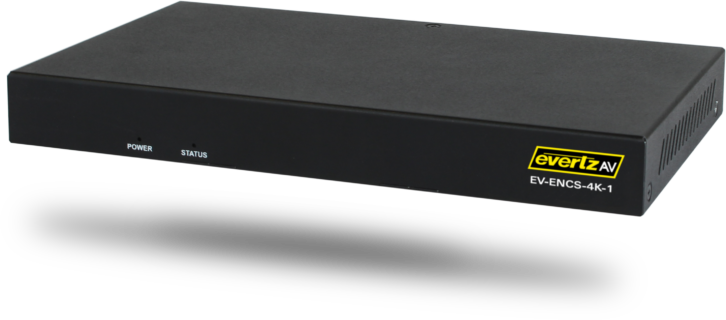 The EvertzAV EV-ENCS-4K-1 4K H.264 encoder is a live streaming media encoder that interfaces with HDMI signals to deliver media over IP networks. It can be used with the 4K H.264 EV-ENCS-4K-1 decoder (or a third-party decoder) for end-to-end streaming systems. It features one HDMI input and one Ethernet output for simplified integration of AV signals over a LAN or WAN.
The EvertzAV EV-ENCS-4K-1 4K H.264 encoder is a live streaming media encoder that interfaces with HDMI signals to deliver media over IP networks. It can be used with the 4K H.264 EV-ENCS-4K-1 decoder (or a third-party decoder) for end-to-end streaming systems. It features one HDMI input and one Ethernet output for simplified integration of AV signals over a LAN or WAN.
 The Extron StudioStation One Touch Recording and Streaming Solution is simple to use and empowers instructors and presenters to record and stream high quality content with a single touch. Extron designed StudioStation so that anyone, of any skill level, can quickly and easily record and stream content; a pre-configured package takes the guesswork out of designing, installing, and programming a recording system. For customers wanting to customize StudioStation for their application, an interactive, online, step-by-step StudioStation Builder navigation tool is available.
The Extron StudioStation One Touch Recording and Streaming Solution is simple to use and empowers instructors and presenters to record and stream high quality content with a single touch. Extron designed StudioStation so that anyone, of any skill level, can quickly and easily record and stream content; a pre-configured package takes the guesswork out of designing, installing, and programming a recording system. For customers wanting to customize StudioStation for their application, an interactive, online, step-by-step StudioStation Builder navigation tool is available.
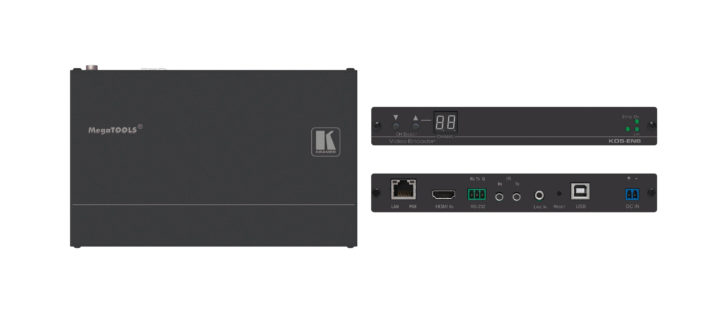 The Kramer Electronics KDS-EN6 encoder does 4K@60Hz (4:2:0) video streaming in addition to audio, IR, RS−232, USB on IP networks in unicast or multicast through RTSP. Sound is input on the HDMI or through the direct audio 3.5mm line-in port. The unit can handle 7.1 PCM, Dolby True–HD, and DTS–HD Master audio. The system is HDCP 2.2 compliant and it can run on an external power supply or PoE. The RS-232 port is on a terminal block and the IR connection is a 3.5mm mini jack. The front panel includes a reset button, up and down buttons and 7-segment display along with status, link and power LEDs.
The Kramer Electronics KDS-EN6 encoder does 4K@60Hz (4:2:0) video streaming in addition to audio, IR, RS−232, USB on IP networks in unicast or multicast through RTSP. Sound is input on the HDMI or through the direct audio 3.5mm line-in port. The unit can handle 7.1 PCM, Dolby True–HD, and DTS–HD Master audio. The system is HDCP 2.2 compliant and it can run on an external power supply or PoE. The RS-232 port is on a terminal block and the IR connection is a 3.5mm mini jack. The front panel includes a reset button, up and down buttons and 7-segment display along with status, link and power LEDs.
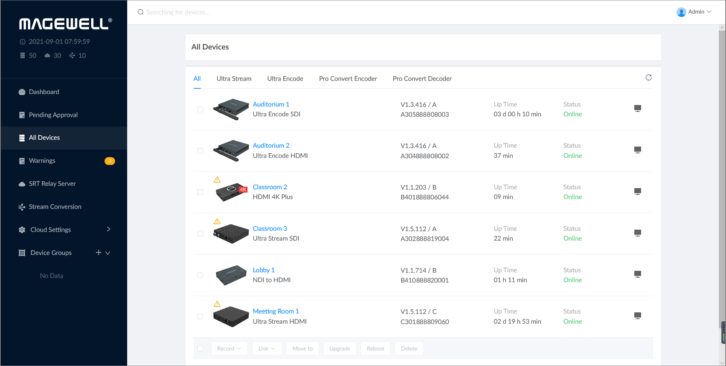 The new Magewell Cloud multi-device management software provides centralized configuration and control of multiple Magewell IP encoders and decoders including the Ultra Stream family of live streaming and recording appliances, the Ultra Encode series of universal live media encoders and the Pro Convert portfolio of encoders and decoders. It also offers stream management features including protocol conversion and SRT gateway functionality. Once the Magewell hardware devices have been registered to a Magewell Cloud installation, users can remotely configure device parameters, monitor the status of each device, trigger operational functions and perform batch firmware upgrades across multiple units of the same model. Administrators can also group devices together and assign permissions for different devices or groups. Magewell Cloud simplifies one-to-many or many-to-many streaming with the Secure Reliable Transport (SRT) protocol by serving as an SRT gateway. SRT-capable Magewell devices and third-party SRT products can connect to Magewell Cloud rather than directly to each other. While the SRT protocol enables secure, reliable and low-latency transmission over unpredictable networks such as the public internet, many legacy encoders and decoders do not directly support SRT. The Magewell Cloud platform can convert streams bi-directionally between RTMP and SRT. Magewell Cloud is delivered as a Docker container, enabling deployment on Windows, Linux and MacOS computing platforms with minimal configuration requirements. Customers can run Magewell Cloud on their own private server or public cloud infrastructures such as Amazon Web Services (AWS) or Microsoft Azure and can view the host platform’s CPU, memory and network usage through Magewell Cloud’s browserbased GUI. The Magewell Cloud software is now in beta testing, with general availability expected later in Q3 2021. Users interested in beta testing a pre-release version of the software are invited to submit a request through the Magewell website.
The new Magewell Cloud multi-device management software provides centralized configuration and control of multiple Magewell IP encoders and decoders including the Ultra Stream family of live streaming and recording appliances, the Ultra Encode series of universal live media encoders and the Pro Convert portfolio of encoders and decoders. It also offers stream management features including protocol conversion and SRT gateway functionality. Once the Magewell hardware devices have been registered to a Magewell Cloud installation, users can remotely configure device parameters, monitor the status of each device, trigger operational functions and perform batch firmware upgrades across multiple units of the same model. Administrators can also group devices together and assign permissions for different devices or groups. Magewell Cloud simplifies one-to-many or many-to-many streaming with the Secure Reliable Transport (SRT) protocol by serving as an SRT gateway. SRT-capable Magewell devices and third-party SRT products can connect to Magewell Cloud rather than directly to each other. While the SRT protocol enables secure, reliable and low-latency transmission over unpredictable networks such as the public internet, many legacy encoders and decoders do not directly support SRT. The Magewell Cloud platform can convert streams bi-directionally between RTMP and SRT. Magewell Cloud is delivered as a Docker container, enabling deployment on Windows, Linux and MacOS computing platforms with minimal configuration requirements. Customers can run Magewell Cloud on their own private server or public cloud infrastructures such as Amazon Web Services (AWS) or Microsoft Azure and can view the host platform’s CPU, memory and network usage through Magewell Cloud’s browserbased GUI. The Magewell Cloud software is now in beta testing, with general availability expected later in Q3 2021. Users interested in beta testing a pre-release version of the software are invited to submit a request through the Magewell website.
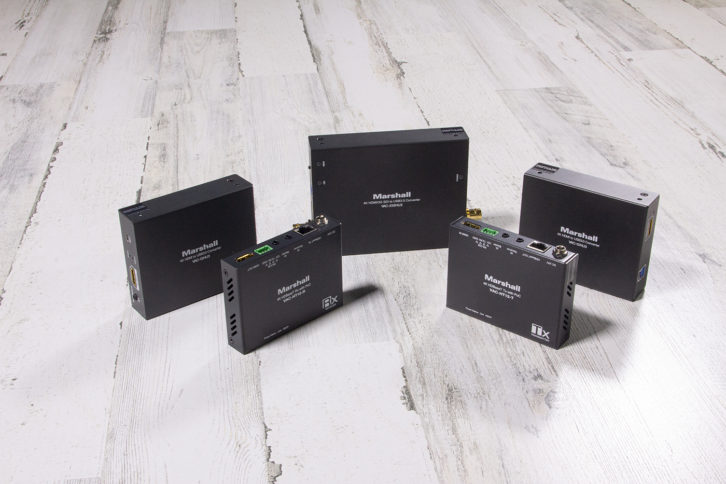 In response to increased global demand for streaming last year, Marshall Electronics enhanced the 3GSDI/HDMI to USB 3.0 converter product category. The VAC23SHU3 USB 3.0 adapter enables any HDMI or 3G/HD-SDI video and audio source to be ingested into a computer for live streaming, videoconference, collaboration, video production, and recording. These converters are simple to use and integrate with professional video sources and the user’s choice of PC-based soft codecs and applications.
In response to increased global demand for streaming last year, Marshall Electronics enhanced the 3GSDI/HDMI to USB 3.0 converter product category. The VAC23SHU3 USB 3.0 adapter enables any HDMI or 3G/HD-SDI video and audio source to be ingested into a computer for live streaming, videoconference, collaboration, video production, and recording. These converters are simple to use and integrate with professional video sources and the user’s choice of PC-based soft codecs and applications.
 In August, Matrox Video announced an expansion to its AV-over-IP portfolio with the new Matrox Maevex 6152 quad-4K and Maevex 6122 dual-4K H.264 encoders. These nextgeneration Maevex encoders feature multi4Kp60 4:4:4 capture and claim zero-latency pass-through while simultaneously delivering multiple 4K streams and recordings. Equipped with multiple streaming protocols (including HLS, MPEG2-TS, RTP, RTMP, RTSP, and SRT); HDCP 2.2 support; and complimentary Maevex SDKs and APIs, these Maevex encoders are designed for demanding AV content distribution in control rooms, operation centers, medical environments, and other critical settings. The Maevex H.264 encoders simultaneously ensure secure, high-density encoding of up to four 4Kp30, two 4Kp60, or many more lower resolution streams and recordings over LAN, WAN, and Internet. When coupled with the Maevex 6152 decoder, the platform also doubles as both a high-density AV-overIP solution and an inter-facility gateway solution to bridge signal management assets from multiple sites. Built on the same 1U ½ rack form factor as the previous generation Maevex 6100 Series encoders, the new appliances each include an on-device LCD screen and six buttons to enable installation, streaming, and recording operations directly on the hardware. In addition, the included PowerStream Plus software allows users to centrally manage all Maevex devices, streams, and recordings, while complimentary Maevex APIs and SDKs allow developers to build new applications or integrate the PowerStream Plus functionalities into existing applications.
In August, Matrox Video announced an expansion to its AV-over-IP portfolio with the new Matrox Maevex 6152 quad-4K and Maevex 6122 dual-4K H.264 encoders. These nextgeneration Maevex encoders feature multi4Kp60 4:4:4 capture and claim zero-latency pass-through while simultaneously delivering multiple 4K streams and recordings. Equipped with multiple streaming protocols (including HLS, MPEG2-TS, RTP, RTMP, RTSP, and SRT); HDCP 2.2 support; and complimentary Maevex SDKs and APIs, these Maevex encoders are designed for demanding AV content distribution in control rooms, operation centers, medical environments, and other critical settings. The Maevex H.264 encoders simultaneously ensure secure, high-density encoding of up to four 4Kp30, two 4Kp60, or many more lower resolution streams and recordings over LAN, WAN, and Internet. When coupled with the Maevex 6152 decoder, the platform also doubles as both a high-density AV-overIP solution and an inter-facility gateway solution to bridge signal management assets from multiple sites. Built on the same 1U ½ rack form factor as the previous generation Maevex 6100 Series encoders, the new appliances each include an on-device LCD screen and six buttons to enable installation, streaming, and recording operations directly on the hardware. In addition, the included PowerStream Plus software allows users to centrally manage all Maevex devices, streams, and recordings, while complimentary Maevex APIs and SDKs allow developers to build new applications or integrate the PowerStream Plus functionalities into existing applications.
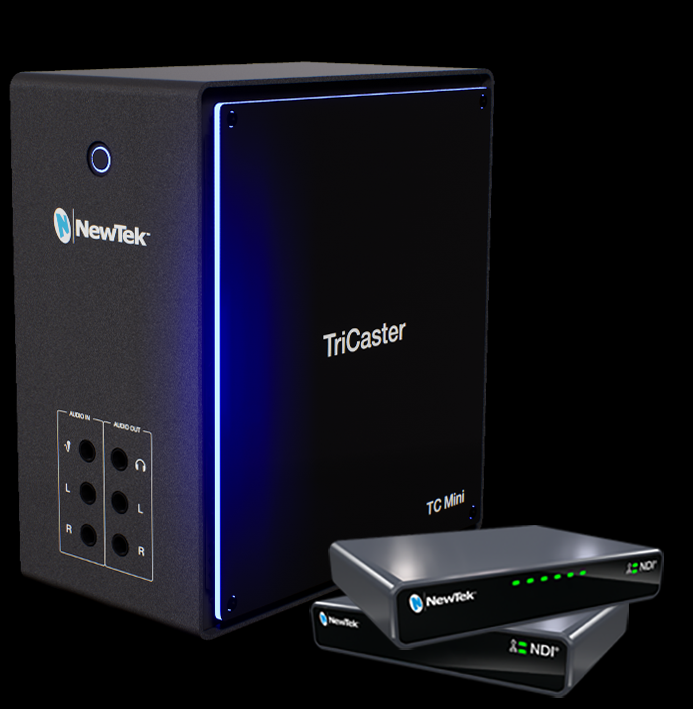 NewTek TriCaster Mini 4K software updates have included new automation and remote control features including Live Story Creator and LivePanel, which complement existing virtual sets, remote guest calling, social media integration, web broadcasting, and more. Virtual sets allow users to turn any living room, garage, or basement into a professional studio reflecting the identity or brand of any business, house of worship, school, or agency. Broadcast graphics, media playback, one touch automated control, multichannel remote Skype video calling, integrated replay, social media integration, and more are all available at up to full UHD p60 resolution. The Live Story Creator allows an individual to run an entire production from a Microsoft Word document; a script triggers actions when loaded into the TriCaster Mini 4K, allowing the storyteller to concentrate solely on delivery of the message rather than on technical setup and production. The LivePanel feature introduces customizable, browser-based remote control of the TriCaster Mini 4K from anywhere on the same LAN, letting anyone including the presenter control live switching, compositing, mix/effects, media playback, audio, automation, and more, from devices including tablets, smartphones, and laptops. Configurable macros are now also supported. Two channels of Skype input allows simultaneous guest contributors to participate from their studios, laptops, or phones across the globe, all presented with broadcast graphics for titles, double box effects, and more. TriCaster Mini 4K ships with Spark Plus IO 4K p60 encode/decode converters, enabling IP-based, NDI-first workflows using existing inputs and outputs.
NewTek TriCaster Mini 4K software updates have included new automation and remote control features including Live Story Creator and LivePanel, which complement existing virtual sets, remote guest calling, social media integration, web broadcasting, and more. Virtual sets allow users to turn any living room, garage, or basement into a professional studio reflecting the identity or brand of any business, house of worship, school, or agency. Broadcast graphics, media playback, one touch automated control, multichannel remote Skype video calling, integrated replay, social media integration, and more are all available at up to full UHD p60 resolution. The Live Story Creator allows an individual to run an entire production from a Microsoft Word document; a script triggers actions when loaded into the TriCaster Mini 4K, allowing the storyteller to concentrate solely on delivery of the message rather than on technical setup and production. The LivePanel feature introduces customizable, browser-based remote control of the TriCaster Mini 4K from anywhere on the same LAN, letting anyone including the presenter control live switching, compositing, mix/effects, media playback, audio, automation, and more, from devices including tablets, smartphones, and laptops. Configurable macros are now also supported. Two channels of Skype input allows simultaneous guest contributors to participate from their studios, laptops, or phones across the globe, all presented with broadcast graphics for titles, double box effects, and more. TriCaster Mini 4K ships with Spark Plus IO 4K p60 encode/decode converters, enabling IP-based, NDI-first workflows using existing inputs and outputs.
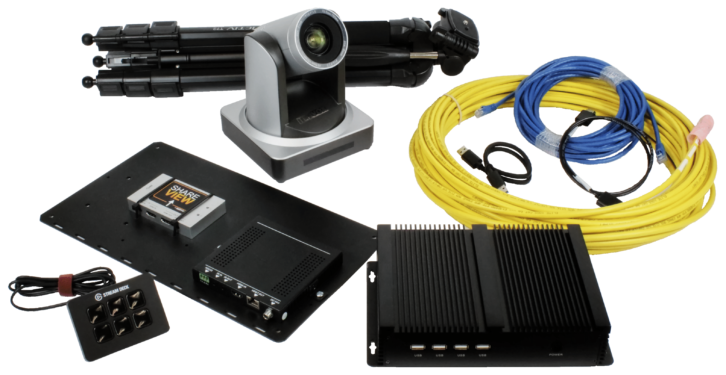 The TEKVOX 71206-DI and 71208-DI Drop-In Live Streaming Mobile Kits solutions are affordable, professional-quality, self-contained packages suitable for any space. They are pre-programmed and mounted and with minimal cabling. The two Live Streaming Mobile Kits have similar specifications, with the 71206-DI offering a single PTZ camera and the 71208-DI offering dual PTZ cameras. The cameras have preset positions, single-cable connection, 5x or 20x optical zoom, and studio-quality mics. Convenient, intuitive control of the cameras and live streaming is done with a StreamDeck Mini controller. Audio, video and integration is pre-programmed and tested. Either system can be equipped with an optional factory-programmed DSP for sophisticated acoustics processing and echo cancellation. The PTZ cameras are connected via HDBaseT so video, control signals and power travel through a single cable for a clean, no-mess setup. This Drop-In is compatible with any web-based videoconferencing software, including Zoom, Facebook Live, Teams, Skype, BlueJeans and WebEx, as well as Youtube.
The TEKVOX 71206-DI and 71208-DI Drop-In Live Streaming Mobile Kits solutions are affordable, professional-quality, self-contained packages suitable for any space. They are pre-programmed and mounted and with minimal cabling. The two Live Streaming Mobile Kits have similar specifications, with the 71206-DI offering a single PTZ camera and the 71208-DI offering dual PTZ cameras. The cameras have preset positions, single-cable connection, 5x or 20x optical zoom, and studio-quality mics. Convenient, intuitive control of the cameras and live streaming is done with a StreamDeck Mini controller. Audio, video and integration is pre-programmed and tested. Either system can be equipped with an optional factory-programmed DSP for sophisticated acoustics processing and echo cancellation. The PTZ cameras are connected via HDBaseT so video, control signals and power travel through a single cable for a clean, no-mess setup. This Drop-In is compatible with any web-based videoconferencing software, including Zoom, Facebook Live, Teams, Skype, BlueJeans and WebEx, as well as Youtube.
 The VITEC MGW ChannelLink IP distribution gateway serves large, often global operations in broadcast, corporate, and government. The appliance acts as a central hub where IP channels from the field can be received and reliably retransmitted live over any IP network. It can receive a large number of input streams and translate them into a multicast or unicast MPEG Transport Stream over UDP (UDP TS) or an SRT-protected stream. When used in conjunction with VITEC’s MGW Ace Encoder and Decoder in its ultralow-latency HEVC profile, the gateway provides optimized end-to-end latency. The solution enables remote production and contribution over the Internet. MGW ChannelLink is also interoperable with third-party encoders and decoders; the compression-standard agnostic gateway is compatible with MPEG-2, H.264, and HEVC codecs, any resolution and frame rate (SD, HD, 4K, and more), and is engineered to evolve and support future transport protocols. Users can manage all incoming channels from around the world and view information and statistics, such as quality of the network link and packet loss. The gateway also provides users with a centralized location for aggregating content and monitoring incoming streams. VITEC’s MGW ChannelLink is well suited for stream management, routing, rebroadcasting, or IPTV stream reflection over WAN or the Internet, including for secure government and military full-motion video applications. Ideal for integrating with the ChannelLink gateway, VITEC’s popular MGW ACE Encoder uses HEVC/H.265 compression for ultra low latency HEVC streaming down to 16ms glass-to-glass while still supporting H.264 as well. Powered by the VITEC HEVC GEN2+ encoder, the unit enables TimeSynchronized Playback and it features a portable, low-power hardware design running on 28 volts. The system ensures synchronization of multiple independent IP streams. Input formats include 3G-SDI, HD-SDI, SD-SDI, DVI, HDMI and Composite video, along with analog and digital sound. A built-in video matrix enables routing of video sources to both the HEVC and H.264 compression cores for simultaneous H.265 and H.264 streaming.
The VITEC MGW ChannelLink IP distribution gateway serves large, often global operations in broadcast, corporate, and government. The appliance acts as a central hub where IP channels from the field can be received and reliably retransmitted live over any IP network. It can receive a large number of input streams and translate them into a multicast or unicast MPEG Transport Stream over UDP (UDP TS) or an SRT-protected stream. When used in conjunction with VITEC’s MGW Ace Encoder and Decoder in its ultralow-latency HEVC profile, the gateway provides optimized end-to-end latency. The solution enables remote production and contribution over the Internet. MGW ChannelLink is also interoperable with third-party encoders and decoders; the compression-standard agnostic gateway is compatible with MPEG-2, H.264, and HEVC codecs, any resolution and frame rate (SD, HD, 4K, and more), and is engineered to evolve and support future transport protocols. Users can manage all incoming channels from around the world and view information and statistics, such as quality of the network link and packet loss. The gateway also provides users with a centralized location for aggregating content and monitoring incoming streams. VITEC’s MGW ChannelLink is well suited for stream management, routing, rebroadcasting, or IPTV stream reflection over WAN or the Internet, including for secure government and military full-motion video applications. Ideal for integrating with the ChannelLink gateway, VITEC’s popular MGW ACE Encoder uses HEVC/H.265 compression for ultra low latency HEVC streaming down to 16ms glass-to-glass while still supporting H.264 as well. Powered by the VITEC HEVC GEN2+ encoder, the unit enables TimeSynchronized Playback and it features a portable, low-power hardware design running on 28 volts. The system ensures synchronization of multiple independent IP streams. Input formats include 3G-SDI, HD-SDI, SD-SDI, DVI, HDMI and Composite video, along with analog and digital sound. A built-in video matrix enables routing of video sources to both the HEVC and H.264 compression cores for simultaneous H.265 and H.264 streaming.
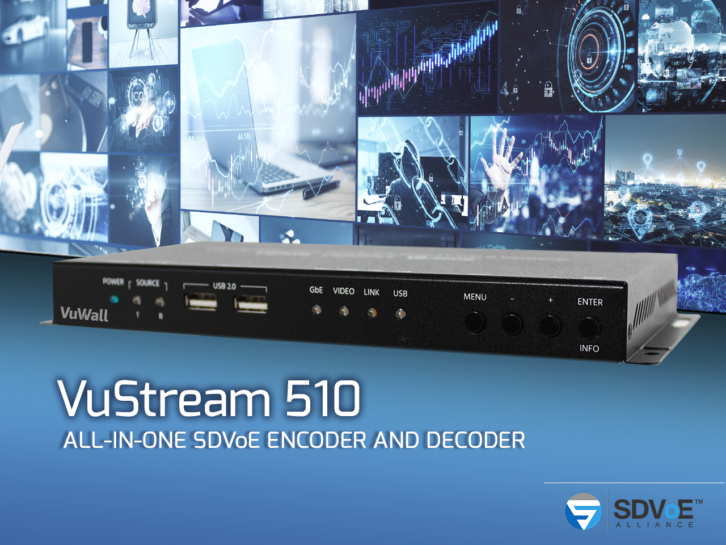 In August, the VuWall VuStream 510 appliance debuted as an expansion to the VuStream encoder and decoder family. Fully SDVoE compatible, the VuStream 510 encodes and decodes in the same compact, all-in-one device. It distributes 4K60 4:4:4 digital video and audio over standard IP network switches and supports DisplayPort and HDMI autoswitching. The VuStream 510 series enables the extension, switching and compositing of real-time signals using standard 10Gb network hardware. In combination with the VuWall TRx centralized management platform, this solution simplifies the management and deployment of devices. As an SDVoE streaming appliance, VuStream 510 is interoperable with other third-party SDVoEsupported solutions. It is available in fiber (VuStream 510-F) and copper (VuStream 510- C) options, both supporting uncompressed 4K video streams in 4:4:4 video format, including HDR, with end-to-end AES 128-bit encryption for secure data transport. The device features transceiver mode (which enables it to encode and decode streams simultaneously) including a loop-through output. It is also fanless and supports USB 2.0 and HDCP 2.2.
In August, the VuWall VuStream 510 appliance debuted as an expansion to the VuStream encoder and decoder family. Fully SDVoE compatible, the VuStream 510 encodes and decodes in the same compact, all-in-one device. It distributes 4K60 4:4:4 digital video and audio over standard IP network switches and supports DisplayPort and HDMI autoswitching. The VuStream 510 series enables the extension, switching and compositing of real-time signals using standard 10Gb network hardware. In combination with the VuWall TRx centralized management platform, this solution simplifies the management and deployment of devices. As an SDVoE streaming appliance, VuStream 510 is interoperable with other third-party SDVoEsupported solutions. It is available in fiber (VuStream 510-F) and copper (VuStream 510- C) options, both supporting uncompressed 4K video streams in 4:4:4 video format, including HDR, with end-to-end AES 128-bit encryption for secure data transport. The device features transceiver mode (which enables it to encode and decode streams simultaneously) including a loop-through output. It is also fanless and supports USB 2.0 and HDCP 2.2.


